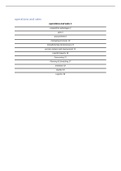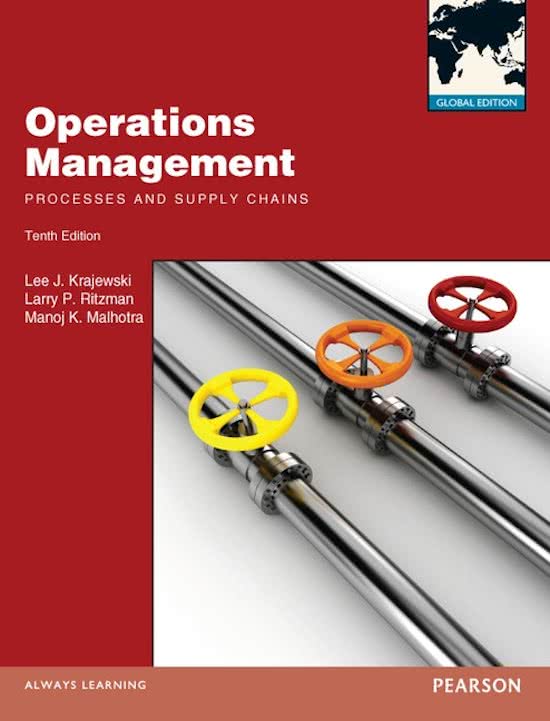operations and sales
operations and sales 1
competitive advantages 2
sales 5
procurement 6
managing processes 10
manufacturing and processes 13
process analysis and improvement 15
Load & Capacity 18
Forecasting 21
Planning & Scheduling 27
Inventory 32
Quality 34
Logistics 38
,competitive advantages
explain the concept of order winner and order qualifiers
A company must have the ability to identify customer needs AND have the appropriate
range of goods or services to meet them.
order qualifiers: Order Qualifying factors are characteristics of a product that are
required for it to be even considered by a customer…
order winners: Order Winners are the characteristics of a product that directly
contribute to winning business from a customer
list and describe the 5 elements of creating competitive advantage
Cost The ability to provide a product or service at a price the customer is
willing to pay
Quality The ability to provide products or services that meet customers’
expectations
Flexibility The ability to change a product or service to meet customer’s needs
Dependability The ability of an organization to consistently meet its promises to the
customer
Speed The ability to provide products or services with as short a time delay as
possible between customer order and delivery
The value that's created and captured by a company is the profit margin:
Value Created & Captured – Cost of Creating that Value = Profit Margin
The more value an organization creates, the more profitable it is likely to be. And when you
provide more value to your customers, you build competitive advantage
describe the interaction between different organizational functions according to porter
A chain of activities common to all businesses, divided them into primary and support
activities
primary activities: Primary activities relate directly to the physical creation, sale,
maintenance and support of a product or service.
, Inbound All the processes related to receiving, storing, and distributing inputs
logistics internally. Your supplier relationships are a key factor in creating value
here.
Operations The transformation activities that change inputs into outputs that are
sold to customers.
Outbound These activities deliver your product or service to your customer. E.g.
logistics collection, storage, distribution systems, and they may be internal or
external to the organisation.
Marketing All the processes you use to persuade clients to purchase from you
and sales instead of your competitors. The benefits you offer, and how well you
communicate them, are sources of value here.
Service These are the activities related to maintaining the value of your product
or service to your customers, once it's been purchased.
support activities: Each Support Activity plays a role in helping the primary activity
Procurement What the organization does to get the resources it needs to operate.
(purchasing) This includes finding suppliers and negotiating the best prices.
Human How well a company recruits, hires, trains, motivates, rewards, and
resource retains its workers. People are a significant source of value, so
management businesses can create a clear advantage with good HR practices.
Technological Activities that relate to managing and processing information.
development Minimizing information technology costs, staying current with
technological advances, and maintaining technical excellence are
sources of value creation.
Infrastructure These are a company's support systems, and the functions that allow
it to maintain daily operations. Accounting, legal, administrative, and
general management are examples of necessary infrastructure that
businesses can use to their advantage.
recognize the importance of each element’s role in creating value
➢ using the value chain in steps
STEP 1 Identify subactivities for each primary activity
= For each primary activity, determine which specific sub-activities create value.
There are 3 different types of sub-activities:
Direct activities create In a book publisher's marketing and sales activity, direct
value by themselves. subactivities include making sales calls to bookstores,
advertising, and selling online.
Indirect activities allow The book publisher's sales and marketing activity, indirect
direct activities to run subactivities include managing the sales force and keeping
smoothly. customer records.
Quality assurance activities The book publisher's sales and marketing activity, this
ensure that activities meet might include proofreading and editing advertisements.
the necessary standards.
STEP 2 Identify subactivities for each support activity.
, = For each of the Support Activities, determine the sub-activities that create value within
each primary activity.
Consider how human resource management adds value to inbound logistics, operations,
outbound logistics, and so on
STEP 3 Identify links
= Find the connections between all of the value activities you've identified.
The links are key to increasing competitive advantage from the value chain framework.
There's a link between developing the sales force (an HR investment) and sales volumes.
There's another link between order turnaround times, and service phone calls from
frustrated customers waiting for deliveries.







